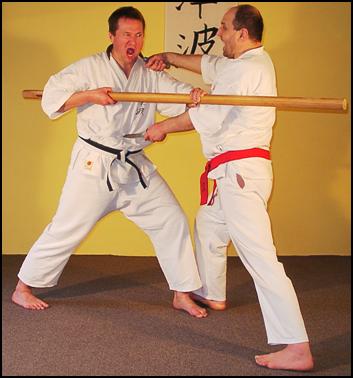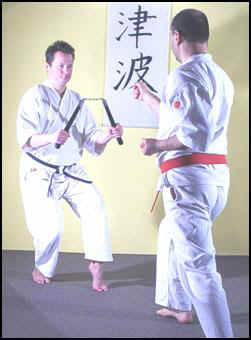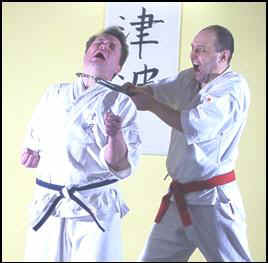| POLISH version |
TRANSLATION
into different languages |
Briefly about the Tsunami |
About Us | Contact |

|
 |
 |  |
Physical improvement in Tsunami style |
Physical improvement in Tsunami style
Improvement propagated by Tsunami in physical aspect (Japanese: shugyo – ‘training, practice’) consists in systematical usage of various well matched exercises:
Aim of using Tsunami mentioned exercises is rising level of health, efficiency and functionality of our bodies.
In Tsunami great attention is paid to stretching exercises. They significantly improve state of health, efficiency and flexibility, and also assure more efficient performing of techniques in fight. This archival photograph show stretching exercises during III Congress of Tsunami instructors, Warsaw 1982. The first from the left: soke Richard Murat.
Great pressure in process physical improvement we lie especially on many-sided using created just for that art of hand-to-hand fighting Tsunami, both without weapons, and with using of different instruments among other things a knife, a long stick, a club, nunchaku, a sickle, tonfa and of other objects.
This art of fighting Tsunami secure most full physical activity, indispensable for health, efficiency and efficiency of our body.
In Tsunami we learn running of fight with an aggressor in two situations: when only he is armed in a dangerous instrument (for example from the left - in nunchaku), and also when we have
such instrument (from the right - throttling with using nunchaku).
Usually it is hardly to understand, that knowledge of the art of hand-to-hand fighting protects us before the lost of health or even life, during an eventual attack of one or several enemies. Training no other discipline would enable us this.
For example, systematic training of basket-ball, tennis, body-building, swimming or light athletics, with no doubt, will bring after the years high level of efficiency and physical health. But our health can be easy lost in case of a bandit attack that comes very often, somehow from robbery reasons, but sometimes even without any reasonable reason.
According that Tsunami system affirms, that our physical health we must not only improve, but also protect efficiency. These two conditions realize the practice of Tsunami art of fighting.
At present, every efficient man should know how to defend himself and also other persons, in the case of attack. This rule refers in the same degree men and women, but traditionally society directs considerably greater expectations in this sphere to men. An attack from the enemies sides can concern in the same degree both men and women (near by it woman are assaulted more often).
For fight with several assailants can perhaps come in once of their attack in reason of hold-up or not to say entertainment. Easily we can then waste health, and even life. Tilling arts of fight Tsunami will permit us efficiently to defend ourselves in such situations.
In illustrations above: fragment of kata - form of Tsunami style Hareta sora (Japanese: ‘clearing up sky’), thanks to it we can learn fight with three attackers simultaneously. This fragment represents the first situation in kata, when two attackers unexpectedly catch us from one side for hands (drawing a), to make possible third bad guys - probably to ringleader measurements to us powerful kicks in kernels (drawing b - view from the back), after which surely will be ‘’finishing up’’ us by those bandits. |
Used here photographs and texts belong to the owner of this site. Copying or using any photographs or fragments of the text without the written permission of the owner of the site is forbidden. Infringing these rights in case of disclosure is punishable civil liability and criminal responsibility. Counter: 966328 |








